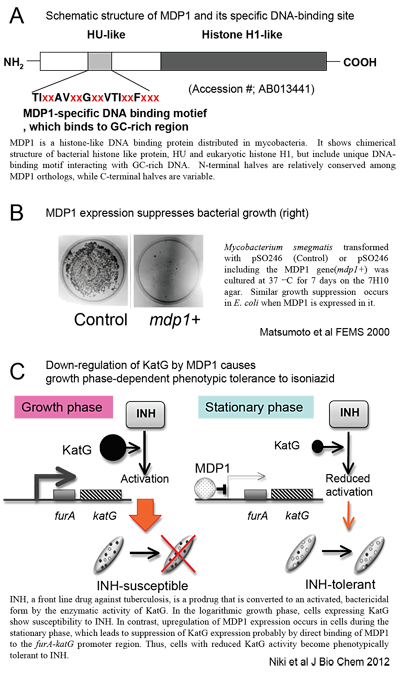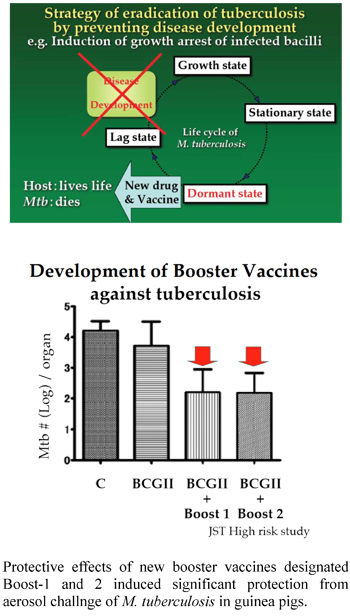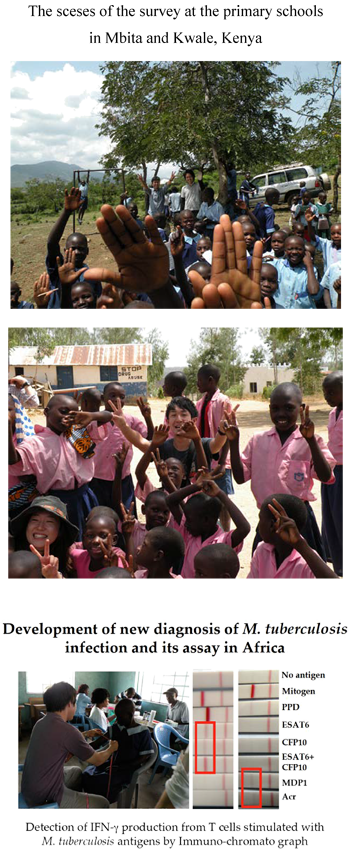1.Research Summary
Our main research is focused on fights against tuberculosis (TB) and related mycobacterial diseases.
2.Research Subjects
3.Research Results
[Area] Bacteriology
[Research subject]
Analysis of the function of the mycobacterial protein and drug development
[Description]
We identified a mycobacterial DNA-binding protein, MDP1 (also designated
HupB, HLP, LBP, Rv2986c), which is a histone-like protein (A). MDP1 has
inhibitory effects on the macromolecular processes, such as DNA replication,
RNA, and protein syntheses, which results in suppression of bacterial growth
(B). MDP1 is an essential protein in slow growers of mycobacteria but is
up-regulated in iron or oxygen-limited condition and participates in the
regulation of gene expression in dormancy.
KatG, which is an essential enzyme for activation of isoniazid (INH), is
one of the genes regulated by MDP1 and therefore up-regulation of MDP1
confers tolerance to isoniazid (C). Besides regulation of gene expression,
MDP1 has iron storage and ferroxidase activities like ferritin, although
there is no obvious sequence similarity. Iron is an essential metal for
almost all living organisms and ferroxidase activity prevents Fenton reaction,
which generates the most aggressive oxygen radical, hydroxyl radical.
Taken together, MDP1 is likely to be involved in growth coordination and
prolonging the life of mycobacteria. Immune response to MDP1 is prominent
in latent TB and thus this protein is a candidate antigen of diagnosis
and vaccine.
[Photographs]

Publications
Matsumoto et al, Microbiol Immunol, 1999. Matsumoto et al, FEMS Microbiol,
2000, Aoki et al J Bio Chem, 2004, Katsube et al, J Bacteriol, 2007, Hirayama
et al, PLoS Pathog, 2009, Takatsuka et al, PLoS One, 2011, NIki et al,
J Bio Chem, 2012. Osada-Oka M, Microbiol Immunol 2013, Niki et al, J Immun
Res 2015, Ozeki Y et al, PLOS ONE 2015, Totani T et al, Sci Rep 2017. Enany
et al, Sci Rep 2017.
[Area] Bacteriology
[Research subject]
Development of the prophylactic interventions against intractable diseases
[Description]
Mycobacterium bovis bacillus Guérin (BCG) is the most widely administered
vaccine in the world and induces protection against leprosy and severe
forms of childhood tuberculosis, and bladder cancer. BCG has some advantages,
such as strong adjuvant activity, long-lasting effects, and safety, and
evaluated for use as a vaccine vehicle. We constructed several recombinant
BCGs and have shown that those are effective against intractable diseases.
While, poor efficacy of BCG for adult pulmonary TB is a serious problem
in controlling TB. We have shown that loss of efficacy over time following
vaccination with BCG even in mice model. Majority of adult TB is arisen
by reactivation from latent infection. Although TB is the serious disease,
we consider that eradication of it is possible if we can effectively prevent
disease development including reactivation (Upper figure). One of strategies
is remaining latent infection by maintaining expression of growth suppressive
molecule, such as MDP1 as described above. We are also trying to develop
new recombinant and booster vaccines against TB as shown in lower figure.
[Photographs]

Publications
Matsumoto S et al, J Exp Med, 1998. Matsumoto S et al, 2000, Vaccine, Yamada
H et al, J Urol, 2001, Ami Y et al, J Viol, 2005, Kanekiyo M et al. J Viol,
2005, Matsumoto S et al J Immunol, 2005. Ozeki Y et al Vaccine, 2011.
[Area] Bacteriology
[Research subject]
Comprehensive health survey in the TB-endemic area
[Description]
We are conducting comprehensive health survey in collaboration with several
institutes including Institutes of Tropical Medicine of Nagasaki University.
The impact of multiple infections including viruses, bacteria, and parasites
has been assessed. We are also aiming to elucidate the impact of ecological
and socio-economic factors that may influence the composition and frequency
of infectious diseases. We first surveyed the prevalence and diversity
of parasitic disease in a rural area of Kenya and found association between
M. tuberculosis and hookworm infections. We also found some of nutrition
factors are risk of M. tuberculosis infection.
Nagi S et al, PLOS Negl Trop Dis 2014
Fujii Y et al, PLOS Negl Trop Dis 2014
Chadeka EA et al, PLOS Negl Trop Dis 2017
Inoue M et al, paper submitted
[Photographs]

Please see the Bacteriology website for a detailed description of our research.
